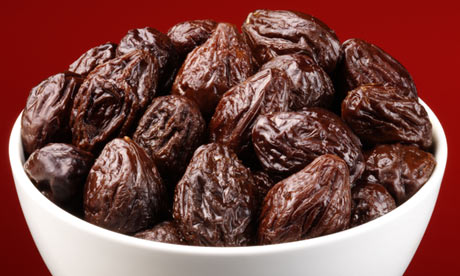
Recently I have tried a couple of recipes that use prunes (dried plums). I was interested to read that prune sales in the UK are on the increase (up by 10% in the last year) and Britain has imported an extra half a million tonnes from California. Some say it is due to the fact that Heston Blumenthal has used them in several of his recipes including his Christmas cake recipe for Waitrose. Shelves were empty of them shortly after. In the past prunes have had a bit of a bad reputation in the UK manly because they were seen as having a laxative effect, but this is in fact a myth. One of the amazing health benefits of prunes is they help in the prevention of osteoporosis (a condition that thins and weakens the bones). This is because they are one of the best sources of vitamin K which is vital for bone health. Studies have shown that eating prunes as opposed to other dried fruits such as apricots, figs or sultanas appears to suppress the breakdown of bones which tends to speed as people age (and especially in post menopausal women). So not only do they taste good in these recipes below they will keep you fit and strong until a ripe old age.
Chicken and Prune Stew
Serves 4
1 teaspoon of olive oil
1 onion peeled and chopped
1 clove of garlic finely chopped
1 teaspoon of turmeric
1/2 teaspoon of cinnamon, coriander and ginger
4 chicken breasts cut into chunks
300ml of chicken stock (150ml if cooking in a slow cooker)
2 tablespoons of tomato puree
200g of ready to eat prunes, halved
Heat the oil in a large shallow pan
Add the onion and cook for five minutes until softened
Add the garlic and spices and cook for another minute
Add the chicken strips and cook for 4-5 minutes until browned (you can also add a splash of water if it is a bit dry)
Add the stock, tomato puree and prunes.
Cook on the hob for 15-20 minutes or in the slow cooker for about 2-3 hours on high or 3-4 on low.
Season to taste with salt and pepper and serve with cous cous and vegetables
Chocolate and prune Mousse
Serves 4-6
100g dark chocolate broken into small pieces
6oz ready to eat prunes
2 tablespoons of brandy (optional)
3 egg whites
1 tablespoon of castor sugar
Break up the chocolate and place in a heatproof bowl over a pan of hot water. Leave until melted then stir and leave to cool slightly
Place the prunes in a small saucepan and barely cover with 150ml of water
Simmer very gently until soft
Transfer the prunes and liquid to a small blender, add the brandy and whiz to a puree
Beat the egg whites in a clean bowl until stiff.
Whisk in half the sugar, then stir in the remaining half
Stir the melted chocolate into the prune puree and beat together
Stir in a spoonful of the egg whites to loosen the mixture then carefully fold in the rest of the egg white
Spoon into small expresso cups or ramekin dishes and chill until required